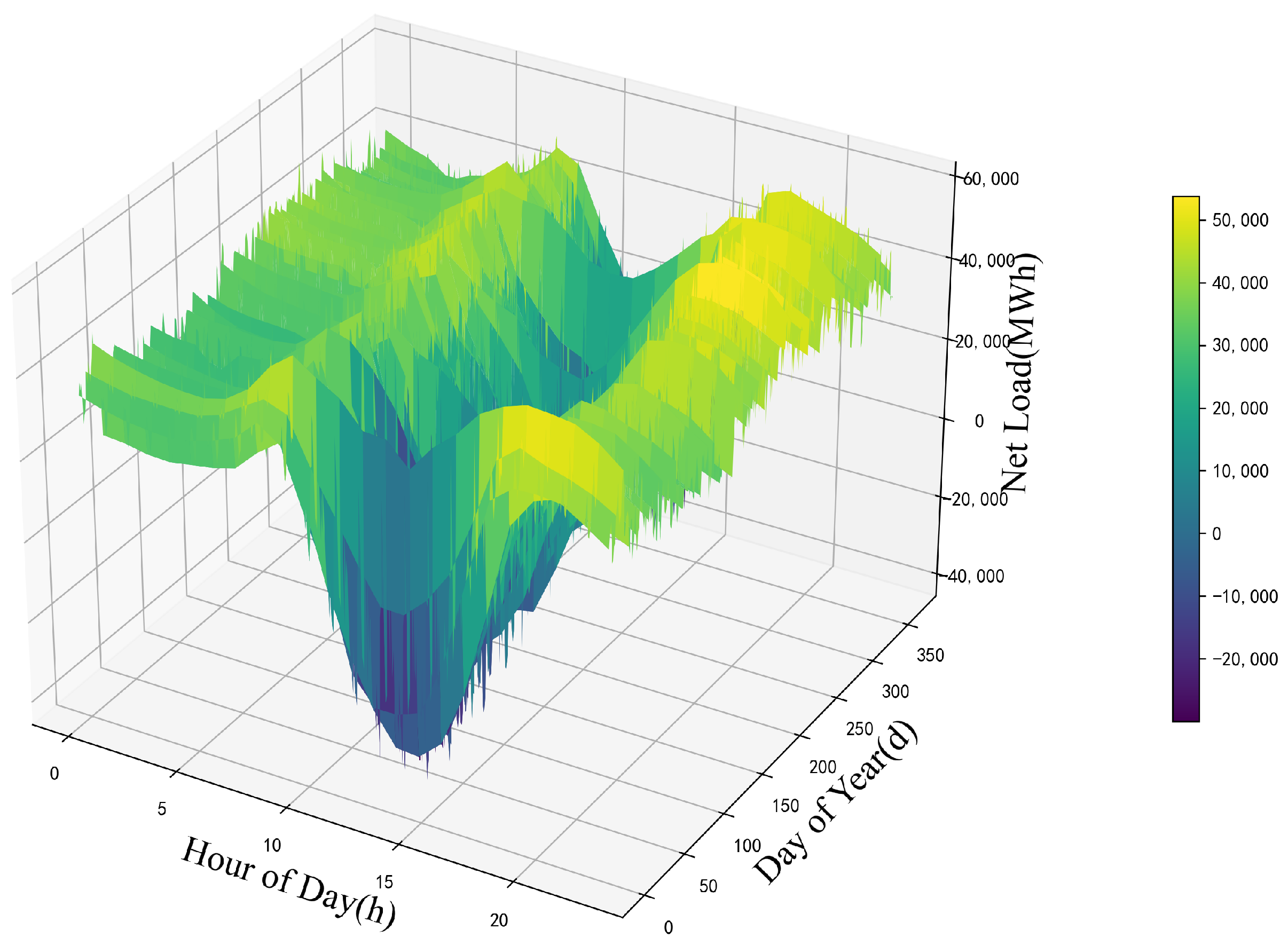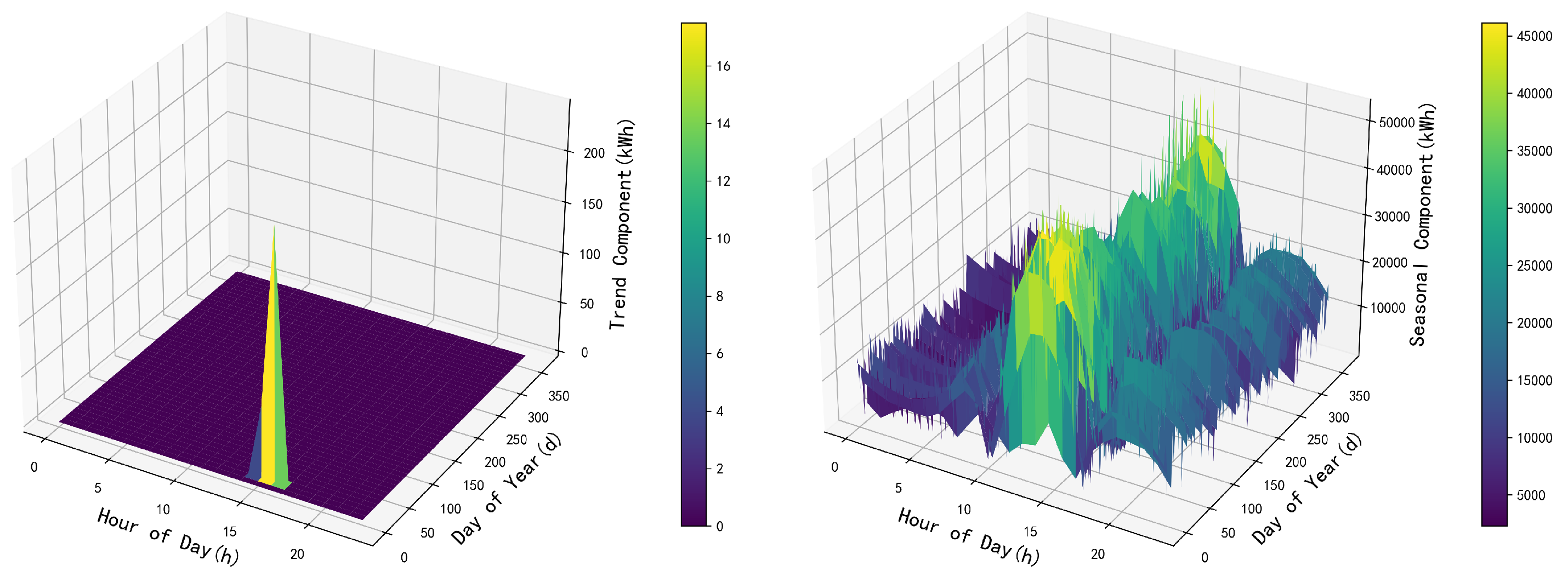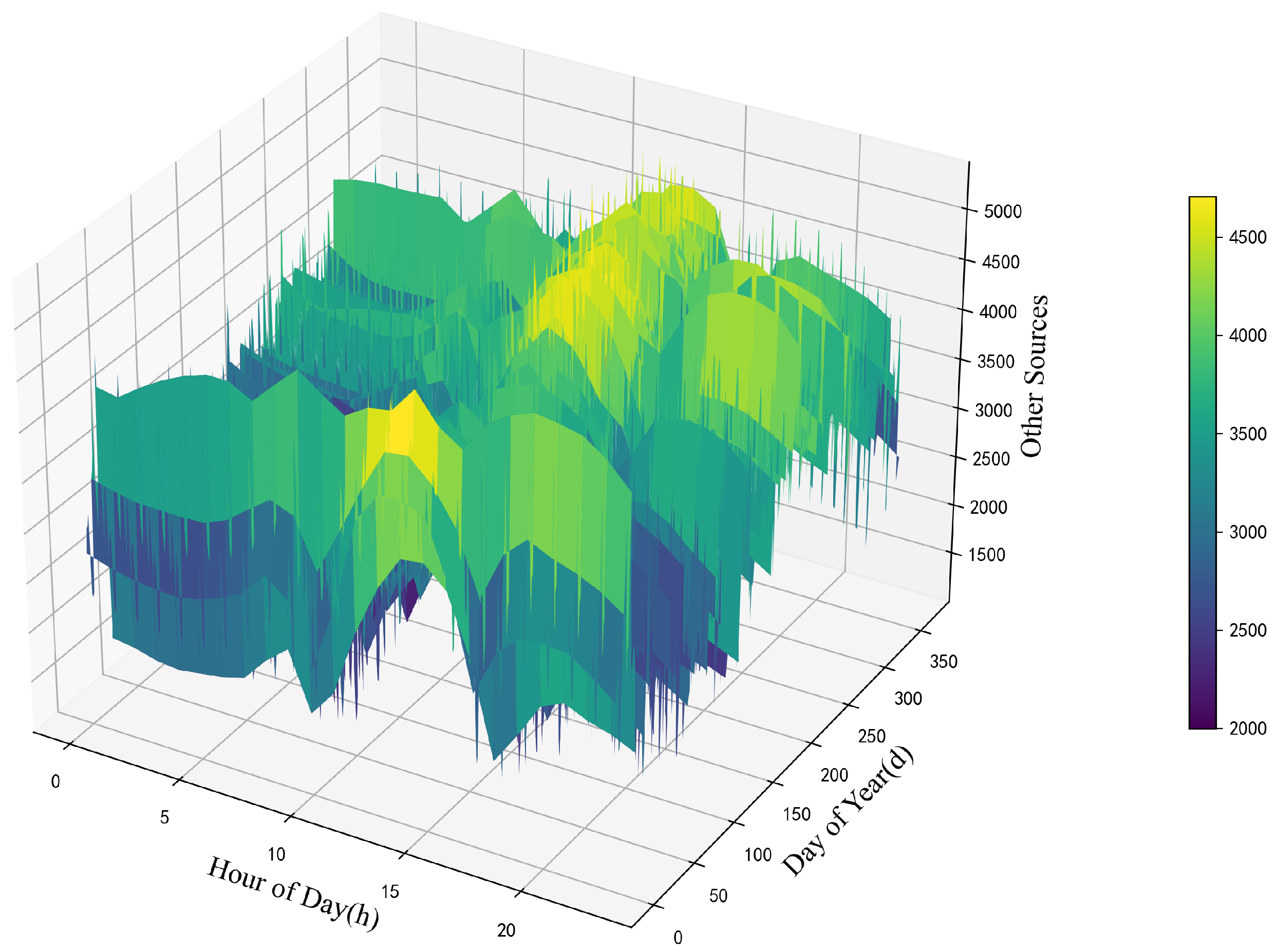Multi-Time-Scale Energy Storage Optimization Configuration for Power Balance in Distribution Systems
Abstract
1. Introduction
- Considering the inclusion of marginal costs in energy storage cost calculations to optimize the relationship between energy storage capacity and storage costs;
- Addressing the characteristics of changes in renewable energy and load profiles with economic development and seasonal variations in the new power system, utilizing a hybrid energy storage technology combining hydrogen storage and chemical energy storage to achieve supply–demand balance;
- Employing Seasonal–Trend decomposition using LOESS (STL) decomposition technology to analyze and decompose data at long time scales, enabling the derivation of regional energy storage deployment schemes.
2. Methodology
2.1. Energy Storage Type Selection
2.2. Energy Storage Planning Methodology
2.3. STL Decomposition Method
3. Mathematical Model
- Only photovoltaic and other renewable energy devices, as well as flexible resources such as energy storage, participate in the operation balance of the power system;
- Considering the insufficiency of renewable energy output to meet the system load demand, the addition of hydrogen energy from alternative sources to compensate for the imbalance in power is being considered;
- Only consider hydrogen obtained through clean energy sources and fed back to the grid through fuel cell technology. The model does not consider the demand for hydrogen energy by the hydrogen industry chain.
3.1. Objective Function
3.2. Constraint Conditions
3.2.1. Power Balance Constraint
3.2.2. Load Cut Constraint
3.2.3. Wind and Solar Spillage Constraint
3.2.4. Battery Operation Constraint
4. Case Study
5. Conclusions
Author Contributions
Funding
Data Availability Statement
Acknowledgments
Conflicts of Interest
Abbreviations
| The following abbreviation is used in this manuscript: | |
| STL | Seasonal and Trend decomposition using Loess |
References
- Ge, X.; Hou, H.; Hou, T. Review of key technologies of low-carbon transition on the power supply side. In Proceedings of the IEEE 5th International Conference on Electronics Technology (ICET), Chengdu, China, 13–16 May 2022; IEEE: Piscataway, NJ, USA, 2022; pp. 275–279. [Google Scholar]
- Denholm, P.; Arent, D.J.; Baldwin, S.F.; Bilello, D.E.; Brinkman, T. The challenges of achieving a 100% renewable electricity system in the United States. Joule 2021, 5, 1331–1352. [Google Scholar] [CrossRef]
- Huang, H.; Zhou, M.; Zhang, S.; Zhang, L.; Li, G.; Sun, T. Exploiting the operational flexibility of wind-integrated hybrid AC/DC power systems. IEEE Trans. Power Syst. 2021, 36, 818–826. [Google Scholar] [CrossRef]
- Lazzeroni, P.; Mariuzzo, I.; Quercio, T. Economic, Energy, and Environmental Analysis of PV with Battery Storage for Italian Households. Electronics 2021, 10, 146. [Google Scholar] [CrossRef]
- Liu, G.Q.; Zeng, Q.; Lei, T. Dynamic risks from climate policy uncertainty: A case study for the natural gas market. Resources 2022, 79, 103014. [Google Scholar] [CrossRef]
- Huang, Y.; Rong, X.; Li, G.; Chen, C.; Bie, Z. Resilience assessment of active distribution systems considering microgrid formation based on grid-edge DERs. IET Gener. Trans. Distrib. 2024, 18, 233–247. [Google Scholar] [CrossRef]
- Tejada-Arango, D.A.; Domeshek, M.; Wogrin, S.; Centeno, E. Enhanced representative days and system states modeling for energy storage investment analysis. IEEE Trans. Power Syst. 2018, 33, 6534–6544. [Google Scholar] [CrossRef]
- Thiran, P.; Jeanmart, H.; Contino, F. Validation of a Method to Select a Priori the Number of Typical Days for Energy System Optimisation Models. Energies 2023, 16, 2772. [Google Scholar] [CrossRef]
- Lajnef, T.; Abid, S.; Ammous, T. Modeling, Control, and Simulation of a Solar Hydrogen/Fuel Cell Hybrid Energy System for Grid-Connected Applications. Adv. Power Electron. 2023, 2013, 352765. [Google Scholar] [CrossRef]
- Diaz, N.L.; Luna, A.C.; Vasquez, T. Centralized control architecture for coordination of distributed renewable generation and energy storage in islanded AC microgrids. IEEE Trans. Power Electron. 2016, 32, 5202–5213. [Google Scholar] [CrossRef]
- Georgios, R.; Refaat, R.; Garcia, T. Review on energy storage systems in microgrids. Electronics 2021, 10, 2134. [Google Scholar] [CrossRef]
- Zsiborács, H.; Baranyai, N.H.; Vincze, T. Intermittent renewable energy sources: The role of energy storage in the European power system of 2040. Electronics 2019, 8, 729. [Google Scholar] [CrossRef]
- Zhou, H.; Bhattacharya, T.; Tran, T. Composite energy storage system involving battery and ultracapacitor with dynamic energy management in microgrid applications. IEEE Trans. Power Electron. 2010, 26, 923–930. [Google Scholar] [CrossRef]
- Pedram, M.; Chang, N.; Kim, T. Hybrid electrical energy storage systems. In Proceedings of the 16th ACM/IEEE International Symposium on Low Power Electronics and Design, Austin, TX, USA, 18–20 August 2010; pp. 363–368. [Google Scholar]
- Javed, K.; Ashfaq, H.; Ashfaq, T. Design and performance analysis of a stand-alone PV system with hybrid energy storage for rural India. Electronics 2019, 8, 952. [Google Scholar] [CrossRef]
- Adedoja, O.S.; Saleh, U.A.; Alesinloye, T. An energy balance and multicriterial approach for the sizing of a hybrid renewable energy system with hydrogen storage. Electron. Energy 2023, 4, 100146. [Google Scholar] [CrossRef]
- Koohi-Fayegh, S.; Rosen, T. A review of energy storage types, applications and recent developments. J. Energy Storage 2020, 27, 101047. [Google Scholar] [CrossRef]
- Raventós, O.; Bartels, J. Evaluation of temporal complexity reduction techniques applied to storage expansion planning in power system models. Energies 2020, 13, 988. [Google Scholar] [CrossRef]
- Zhang, N.; Jiang, H.; Du, T. An Efficient Power System Planning Model Considering Year-Round Hourly Operation Simulation. IEEE Trans. Power Syst. 2022, 37, 4925–4935. [Google Scholar] [CrossRef]
- Jiang, H.; Du, E.; Zhang, T. Renewable Electric Energy System Planning Considering Seasonal Electricity Imbalance Risk. IEEE Trans. Power Syst. 2023, 38, 5432–5444. [Google Scholar] [CrossRef]
- Yu, Z.; Lin, J.; Liu, T. Optimal Sizing of Isolated Renewable Power Systems with Ammonia Synthesis: Model and Solution Approach. arXiv 2024, arXiv:2303.05971. [Google Scholar] [CrossRef]
- Yu, Z.; Lin, J.; Liu, T. Optimal Sizing and Pricing of Grid-Connected Renewable Power to Ammonia Systems Considering the Limited Flexibility of Ammonia Synthesis. IEEE Trans. Power Syst. 2024, 39, 3631–3648. [Google Scholar] [CrossRef]
- Pham, M.C.; Tran, T.Q.; Bacha, T. Optimal sizing of battery energy storage system for an island microgrid. In Proceedings of the IECON 2018—44th Annual Conference of the IEEE Industrial Electronics Society, Washington, DC, USA, 21–23 October 2018; IEEE: Piscataway, NJ, USA, 2018; pp. 1899–1903. [Google Scholar]
- Yu, Y.; Du, E.; Chen, T. Optimal portfolio of a 100% renewable energy generation base supported by concentrating solar power. Renew. Sustain. Energy Rev. 2022, 170, 112937. [Google Scholar] [CrossRef]
- Yan, P.; Zhao, L.; Xie, T. Optimal control method of regional energy interconnection energy storage considering user demand. In Proceedings of the Eighth International Conference on Energy Materials and Electrical Engineering (ICEMEE 2022), Guangzhou, China, 22–24 April 2022; Volume 12598, pp. 239–244. [Google Scholar]
- Garcia-Torres, F.; Bordons, T. Optimal economical schedule of hydrogen-based microgrids with hybrid storage using model predictive control. IEEE Trans. Ind. Electron. 2015, 62, 5195–5207. [Google Scholar] [CrossRef]
- Riyaz, A.; Sadhu, P.K.; Iqbal, T. Comprehensive survey of various energy storage technology used in hybrid energy. Electronics 2021, 10, 2037. [Google Scholar] [CrossRef]
- Barthélémy, T. Hydrogen storage–Industrial prospectives. Int. J. Hydrog. Energy 2012, 37, 17364–17372. [Google Scholar] [CrossRef]
- Preuster, P.; Alekseev, A.; Wasserscheid, T. Hydrogen storage technologies for future energy systems. Annu. Rev. Chem. Biomol. Eng. 2017, 8, 445–471. [Google Scholar] [CrossRef]
- Vivas, F.J.; Segura, F.; Andújar, T. Multi-objective fuzzy logic-based energy management system for microgrids with battery and hydrogen energy storage system. Electronics 2020, 9, 1074. [Google Scholar] [CrossRef]
- Monforti, F.A.; Vivas, F.J.; Segura, T. Hydrogen vs. battery in the long-term operation. A comparative between energy management strategies for hybrid renewable microgrids. Electronics 2020, 9, 698. [Google Scholar] [CrossRef]
- Cleveland, R.B.; Cleveland, W.S.; McRae, T. STL: A seasonal-trend decomposition. J. Off. Stat. 1990, 6, 3–37. [Google Scholar]
- Wang, X.; Smith, K.A.; Hyndman, T. Characteristic-based clustering for time series data. Data Min. Knowl. Discov. 2006, 13, 335–364. [Google Scholar] [CrossRef]
- Wu, J.; Xing, X.; Liu, T. Energy management strategy for grid-tied microgrids considering the energy storage efficiency. IEEE Trans. Ind. Electron. 2018, 65, 9539–9549. [Google Scholar] [CrossRef]










| Outer Loop |
| Calculate weights |
| Inner Loop |
| Step 1: detrend; |
| Step 2: smooth periodic subsequence; |
| Step 3: low-pass filtering of periodic subsequences; |
| Step 4: remove trend from smoothed periodic subsequences; |
| Step 5: detrending; |
| Step 6: trend smoothing. |
| Name | Numerical Values |
|---|---|
| The installation cost of electrochemical energy storage | 1.66 RMB/kWh |
| The installation cost of hydrogen energy storage | 8 RMB/kWh |
| The marginal cost of electrochemical energy storage | 1 RMB/kWh |
| The marginal cost of hydrogen energy storage | 4 RMB/kWh |
| The operating cost of electrochemical energy storage | 0.5 RMB/kWh |
| The operating cost of hydrogen energy storage | 0.1 RMB/kWh |
| The cost of wind and solar spillage | 10 RMB/kWh |
| The cost of load shedding | 15 RMB/kWh |
| The maximum load shedding amount per unit time | 100 kWh/h |
| The maximum wind and solar spillage amount per unit time | 100 kWh/h |
| Case | Hydrogen Storage Capacity | Electrochemical Storage Capacity | Profit |
|---|---|---|---|
| Not considering marginal costs | 47 GWh | 52 GWh | −0.00126% |
| Only hydrogen storage | 70 GWh | 0 | −0.49282% |
| Only electrochemical storage | 0 | 75 GWh | −1.6436% |
| The case of this article | 46 GWh | 51 GWh | \ |
Disclaimer/Publisher’s Note: The statements, opinions and data contained in all publications are solely those of the individual author(s) and contributor(s) and not of MDPI and/or the editor(s). MDPI and/or the editor(s) disclaim responsibility for any injury to people or property resulting from any ideas, methods, instructions or products referred to in the content. |
© 2024 by the authors. Licensee MDPI, Basel, Switzerland. This article is an open access article distributed under the terms and conditions of the Creative Commons Attribution (CC BY) license (https://creativecommons.org/licenses/by/4.0/).
Share and Cite
Lu, Q.; Zhang, X.; Yang, Y.; Hu, Q.; Wu, G.; Huang, Y.; Liu, Y.; Li, G. Multi-Time-Scale Energy Storage Optimization Configuration for Power Balance in Distribution Systems. Electronics 2024, 13, 1379. https://doi.org/10.3390/electronics13071379
Lu Q, Zhang X, Yang Y, Hu Q, Wu G, Huang Y, Liu Y, Li G. Multi-Time-Scale Energy Storage Optimization Configuration for Power Balance in Distribution Systems. Electronics. 2024; 13(7):1379. https://doi.org/10.3390/electronics13071379
Chicago/Turabian StyleLu, Qiuyu, Xiaoman Zhang, Yinguo Yang, Qianwen Hu, Guobing Wu, Yuxiong Huang, Yang Liu, and Gengfeng Li. 2024. "Multi-Time-Scale Energy Storage Optimization Configuration for Power Balance in Distribution Systems" Electronics 13, no. 7: 1379. https://doi.org/10.3390/electronics13071379
APA StyleLu, Q., Zhang, X., Yang, Y., Hu, Q., Wu, G., Huang, Y., Liu, Y., & Li, G. (2024). Multi-Time-Scale Energy Storage Optimization Configuration for Power Balance in Distribution Systems. Electronics, 13(7), 1379. https://doi.org/10.3390/electronics13071379







